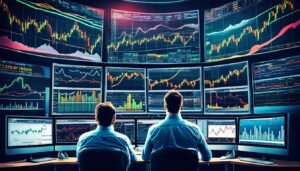
The cryptocurrency market has grown a lot in recent years, now worth over $1 trillion. More investors are looking into quantitative trading strategies to boost their earnings. This method uses science and rules to trade, making it a top pick for those wanting to make the most of the crypto market’s ups and downs.
This article will cover how quantitative trading works in the crypto market. We’ll look at its basics, the strategies traders use, and the rules they follow. We’ll also talk about what the future holds for this fast-changing field. By getting to know quantitative trading for cryptocurrencies, investors can make better choices and possibly earn more.
Introduction to Quantitative Trading in the Cryptocurrency Market
The cryptocurrency market has seen big changes, making quantitative trading more important. This method uses math and stats to change old ways of trading. It uses data and automated programs to cut out human feelings and make trading more precise and efficient.
Quantitative trading is all about using science to understand the market. Traders look at past data to find patterns. Then, they make algorithms that can trade automatically, cutting down on mistakes and feelings.
This approach lets traders make choices based on facts, not feelings. It can lead to steady results and finding market chances others miss.
The growth of quantitative trading in the cryptocurrency market brings new chances and challenges. With algorithmic trading and automated trading strategies, traders can get ahead. Using data and tech, they can handle the ups and downs of crypto better.

The importance of quantitative trading is set to grow as the crypto market changes. Staying up-to-date with the latest in cryptocurrency investment strategies helps traders make the most of this fast-paced market.
Fundamental Concepts and Characteristics of Quantitative Trading
I’ve learned a lot about quantitative trading in the fast-paced crypto market. This method uses characteristics of systematicity, automation, and objectivity. It looks at past market data to find patterns and trends.
Systematicity in quantitative trading means creating strategies and algorithms. These models make trading choices with little human help. This cuts down on emotional mistakes or errors. Being objective is key, as it lets investors make choices based on data, not feelings.
Since the 1980s, tech and the internet have made quantitative trading more common. It’s now used in many financial markets, including crypto. This method uses data and algorithms to help investors improve their crypto investments.
| Characteristic | Description |
|---|---|
| Systematicity | Quantitative trading models the market using scientific methods, studying historical data to find predictable patterns. |
| Automation | By developing trading strategies and algorithms, quantitative trading achieves the automation of trading decisions, significantly reducing the possibility of human errors and emotional decision-making. |
| Objectivity | Quantitative trading is based on data and models, less influenced by individual subjective judgments, thus enhancing the objectivity of trading decisions. |
By using quantitative trading, crypto investors can get ahead in this changing market. Knowing about quantitative trading’s basics is key to making the most of new chances.
The Volatile and Dynamic Nature of Cryptocurrency Markets
I’ve seen the amazing ups and downs of the cryptocurrency market up close. The volatility in cryptocurrency markets is incredible. It offers great chances for skilled traders but also brings big risks.
The market is full of different people, from regular investors to big players, miners, and developers. This mix makes the market lively and challenging for traders. They need to keep changing their plans to stay ahead.
One key thing about the market is it’s decentralized. This means people can trade without needing a middleman, which cuts costs. But, it also brings risks like fraud and hacking. Traders must be ready for these risks.
The 24-hour cryptocurrency market is always open, giving traders more chances to make moves. But, they need to perform well at all hours.
“The cryptocurrency market faces a constantly changing regulatory landscape, and policy shifts can impact market sentiment and trading rules. Quantitative trading strategies must promptly adapt to regulatory uncertainty in crypto to ensure compliance.”
Finding good data is hard for traders in the cryptocurrency market. Data is spread out and not all of it is reliable. Getting past this hurdle is key to making smart trades.
By grasping the special traits of the cryptocurrency market, traders can craft new strategies. These strategies can help them deal with the volatility and dynamism and maybe boost their earnings.
Others also read this article : Cryptocurrency Arbitrage Trading: Making Efficient Use of Market Spreads
Common Quantitative Trading Strategies for Cryptocurrencies
Quantitative trading is now big in the fast-changing crypto markets. Trend-following strategies try to make money off price trends. They use tools like moving averages and the RSI to spot trends and decide when to buy or sell.
Arbitrage strategies take advantage of price differences across exchanges. Traders make money from these differences in things like exchange rates and funding rates. This uses the global linkages of the crypto world.
High-frequency trading (HFT) is big in crypto because of its fast pace and big changes. These algorithms do lots of trades quickly, using fast tech to make money from small price changes.
Using machine learning (ML) and artificial intelligence (AI) has changed crypto trading. These methods look at lots of data to find patterns that help predict prices. They use things like sentiment analysis to stay ahead in the market.
“Quantitative trading strategies are key for dealing with the fast and changing crypto markets. They use data and tech to find special chances and make steady profits.”
The crypto world is always changing, so quantitative trading will keep getting more important. It offers many strategies to help investors and traders make more money.
| Strategy | Description | Key Advantages |
|---|---|---|
| Trend-Following | Capitalizing on the momentum of price trends using technical indicators | Ability to identify and profit from sustained market movements |
| Arbitrage | Exploiting price differences of an asset across different exchanges or market segments | Generating returns from market inefficiencies without directional risk |
| High-Frequency Trading (HFT) | Executing a large number of trades in extremely short timeframes using advanced technology | Capitalizing on brief pricing inefficiencies in the highly volatile crypto markets |
| Machine Learning and AI | Utilizing sophisticated algorithms to analyze vast amounts of data and identify predictive patterns | Gaining a competitive edge by uncovering unique market insights |
Using quantitative trading to enhance cryptocurrency investment returns
I’ve learned the value of quantitative trading in the fast-paced cryptocurrency market. It helps me improve my portfolio and boost my trading profits. By using data and algorithms, I’ve seen my returns go up and beat the market.
Understanding the cryptocurrency market’s ups and downs is key. I picked strategies that fit my risk level and goals. This lets me trade with more confidence and precision.
To get the best results, I use strong trading platforms and data sources. I also have the tools to make and improve my trading strategies. This helps me spot market chances, trade fast and right, and keep risks low.
Quantitative trading is tough but rewarding. By using data and algorithms, I’ve made my investments in cryptocurrency better. I’ve also made my strategies more effective and increased my profits.
“Quantitative trading has been a game-changer for my cryptocurrency investments. The ability to leverage data and algorithms has allowed me to navigate the market’s volatility with greater precision and consistently generate higher returns.”
It’s important to keep up with market news and rules to make sure my strategies work. I watch the market and adjust my plans to stay ahead.
If you want to improve your cryptocurrency investments, check out quantitative trading. It can help you make the most of your investments and grow your profits in this exciting market.
Data Sources and Tools for Quantitative Trading in Crypto
To succeed in the fast-paced crypto market, quantitative traders need good data and strong tools. Data providers like CoinGecko, CryptoCompare, and CoinMarketCap give real-time data on prices, volumes, and market size. This data is key for making and testing trading strategies.
Tools like Python and platforms like CIP(Crypto Investment Platform) and TradingView help create, test, and use algorithmic trading. These tools are vital for quantitative traders.
Crypto exchanges like Binance, Coinbase, and Huobi offer APIs for automating trades. This makes trading more efficient and quick to market changes. Cloud computing services from Amazon AWS, Google Cloud, and Microsoft Azure give scalable computing and storage. This helps traders keep their strategies efficient and cost-effective.
“The integration of data providers, programming tools, and cloud computing is crucial for quantitative traders to gain a competitive edge in the rapidly evolving cryptocurrency market.”
By using these advanced tools, quantitative traders can make the most of data insights and automated decisions. This helps them improve their investment returns and move through the market with more precision and speed.
Risk Management and Capital Allocation in Crypto Quant Trading
In the world of cryptocurrency, managing risks is crucial. Traditional quant strategies focus on volatility and hedging. But, crypto brings new risks like forks, liquidity attacks, and protocol changes. These require a new way of thinking.
Even though a full crypto risk management theory is still being developed, leading models are changing to meet these new challenges.
For success in crypto quant trading, managing your money well is key. The value of digital assets can change a lot, so you need to be careful with your risks. This means spreading your investments out and using strategies like rolling put options.
Adding smart rules for when to sell and using puts and calls together can also help. These methods help control the ups and downs and keep your investments safe.
As crypto quant trading grows, so will the ways we manage risks and allocate money. Staying ahead by being proactive and adaptable is important. This approach will help investors make the most of their cryptocurrency investments with smart strategies.
Others also read this article : How to Use Technical Analysis to Enhance Cryptocurrency Trading Results
Regulatory Considerations and Compliance in Crypto Quant Trading
The cryptocurrency market is always changing. This means the rules for trading with quantitative strategies are getting more complex. Things like needing a license, reporting what you do, and not doing certain trades can affect how well and how much you can make from crypto quant trading.
It’s very important for quant traders to keep up with the regulatory landscape for crypto quantitative trading. This helps them follow the rules and change their plans as needed. Working with legal and compliance experts can make this easier.
Knowing the compliance requirements for crypto quant strategies is key to avoid legal trouble or financial losses. Making sure your trading systems and risk management follow the latest rules is crucial. This is a big part of doing well in crypto quant trading.
Being able to adapt crypto quant trading to regulatory changes gives traders an edge. Adding flexibility and quickness to their systems lets them adjust to new rules and find new chances to make money.
The crypto market is getting more mature, and dealing with complex rules is a big part of being a quant trader. By keeping an eye on the changing rules, following them, and adjusting their plans, crypto quant traders can make the most of this fast-growing market.
Future Trends and Developments in Crypto Quant Trading
The crypto market is perfect for quantitative trading because it’s digital and always changing. Thanks to machine learning and deep learning, we’re seeing new ways to trade. These new methods could change how we trade cryptocurrencies in the future.
New financial tools like DeFi are becoming more popular in trading. These tools offer new ways to make money and take risks. They let traders use the unique features of crypto to create smart trading algorithms.
Technologies like natural language processing and computer vision are changing crypto trading. They help traders find valuable information from lots of data sources. This makes it easier to spot chances to make money in the market.
As we look ahead, we’ll see more advanced trading algorithms for crypto. These will help traders deal with the ups and downs of crypto markets. The mix of new tech and crypto’s special features will lead to big changes in trading strategies.
“The future of quantitative trading in the cryptocurrency market is poised to see significant advancements and innovations that could catalyze a new wave of growth and profitability for quantitative traders.”
Conclusion
In the fast-changing world of blockchain and crypto, quantitative trading is becoming key for investors and traders. I’ve learned how it can boost crypto investment returns and lower risks. This method uses math and algorithms to make trading decisions.
Quantitative trading is all about using systems to trade automatically and fairly. It’s great for the crypto market because it’s volatile. By picking the right strategies, traders can make the most of market chances and get steady returns.
The future of quantitative trading in crypto looks bright. New tech will bring more chances for growth. I’m looking forward to seeing how it will help investors make the most of their crypto investments.





